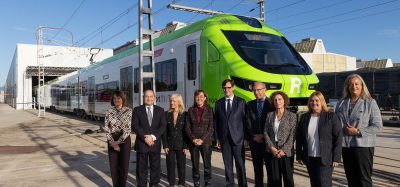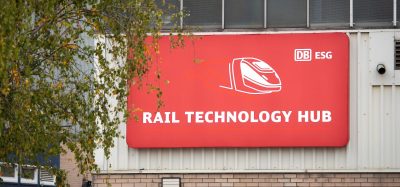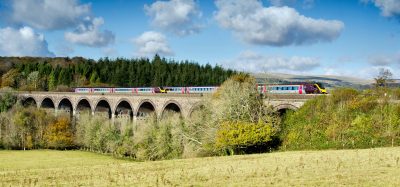The traction power supply of the Wendlingen–Ulm high‑speed rail line
Posted: 12 April 2022 | Christian Lammerskitten | No comments yet
On 12 December 2018, the first overhead contact line (OHL) pole was mounted on the Wendlingen–Ulm high-speed rail line construction project in Germany. On 31 January 2022 the OHL was energised; the high-speed line is now due to open for commercial operations in December 2022. Christian Lammerskitten, Head of Power Supply and Signalling at DB Projekt Stuttgart–Ulm GmbH, provides an overview of the traction power supply system for the line, from the 110 kV level to the 15 kV level.
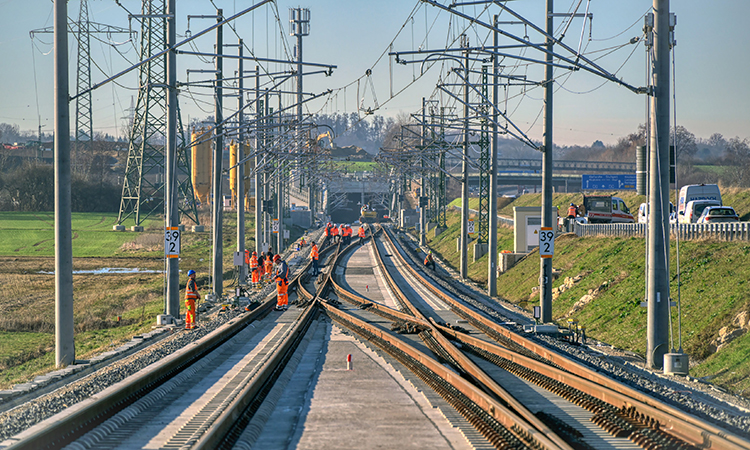

High-speed overhead contact line on a pair of switches. Credit: Arnim Kilgus
The Wendlingen–Ulm high-speed line is part of the German Rail Project Stuttgart–Ulm, which itself is part of the European railway axis Paris–Strasbourg–Stuttgart–Vienna–Bratislava and part of the Rhine-Danube TEN 17 corridor. New and upgraded high-speed lines will operate all the way from Paris to Vienna with high-speed trains capable of running up to 300km/h. By the end of 2025 the completion of Stuttgart 21, the second part of the entire Stuttgart–Ulm project, will significantly decrease the travelling time between Stuttgart and Ulm from 54 minutes to less than 30 minutes. The line is designed for a maximum speed of 250km/h.
The Filstalbahn, the existing connection that was built in the 1840s and has been in operation since 1850 from Ulm to Stuttgart via the Geislinger Steige, allows for maximum speeds of up to 160km/h, but it also has sections limited to a maximum speed of 70km/h due to a curve radius and gradients. For the new line, tunnelling was a major part of the project. Due to the protection of the landscape and a nearly direct line between the city of Ulm and the Stuttgart airport, half of the 59.5km-long line are running in tunnels.
Traction power supply
In Germany, traction power supply for main line train operations is realised with a voltage of 15kV/16,7Hz. Although the decentralised converter stations are allowed to feed 15kV/16,7Hz sections from the high voltage 50Hz utility networks, most of the electrified tracks are supplied by the 7,800km long, Deutsche Bahn (DB) owned 110kV, 16,7Hz single phase central network.
The 110kV lines are the backbone for a reliable, safe and environmentally sustainable railway operation. Currently, more than 60 per cent of the energy is produced from renewable resources. The target for DB is to increase the use of renewable energy to 100 per cent by 2038. For the Wendlingen–Ulm project, two new substations, two new switching stations, as well as two new 110kV overhead line links and more than 150km of overhead contact line have been built.
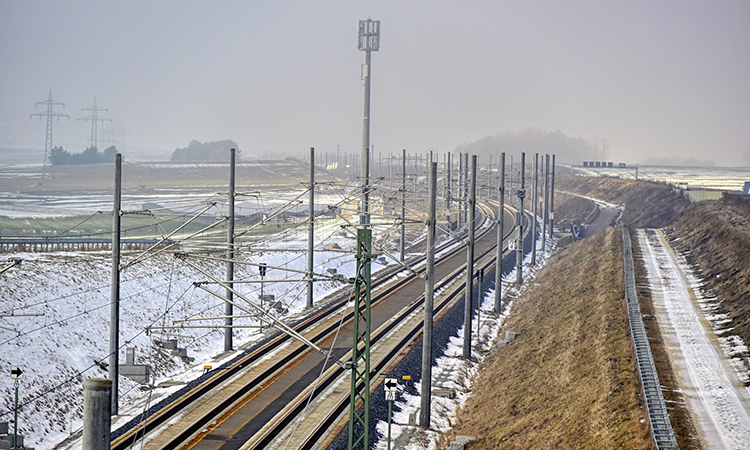

High-speed overhead contact line on a pair of switches. Credit: Arnim Kilgus
110 kV overhead lines
The existing 110kV/16,7Hz overhead line connection between Munich and Stuttgart is an important part of the railway network in southern Germany as it connects the two main cities in the future within a one hour 30 minutes travel time. This OHL is also feeding the Filstalbahn, the existing connection between Ulm and Stuttgart. As the new line was built south of the existing line, links to the new line had to be realised.
To minimise environmental impact, the new overhead lines are mainly realised by converting existing high voltage utility lines of Netze BW GmbH to jointly used overhead lines operated by DB Energie and Netze BW GmbH.
For the Wendlingen–Ulm project, two new substations, two new switching stations, as well as two new 110kV overhead line links and more than 150km of overhead contact line have been built.
As the high voltage lines of Netze BW are an important part of the security in the region, work on the line had to be well coordinated with Netze BW, as the whole line had to be changed to new poles in only short outages. The new poles then allowed the installation of the two additional 110kV/16,7Hz systems at each pole.
The result of these ideas are the lines ‘BL 592’ and ‘BL 593’:
- BL 592 Abzw. II Amstetten–Merklingen (replacement of 39 poles, new construction: three poles)
- BL 593 Abzw. – Uw Nabern (replacement of 39 poles, new construction: three poles).
Both lines were completed by the end of 2021 and are now in service.
Substations
Substations for DB in Germany are highly standardised. All major components and subsystems are defined in detail and are supplied via framework contracts to the project. This includes the 110kV switchgear, traction transformer, 15kV indoor switchgear and control and protection equipment.
The two substations, each fitted with two 15MW transformer, are located close to the villages of Merklingen and Nabern.
A substation on the central 110kV grid consists principally of the following systems:
- 110kV outdoor switchgear
- Transformer
- 15kV indoor switchgear
- Substation control and protection system
- Substation axillary power supply.
110kV switchgear
The 110kV switchgear, according to the DB standard block substation scheme, consists of two feeders, a single busbar and two circuit breaker transformer panels. The substation in Merklingen is prepared for a future extension of a third transformer. Two compact switchgear modules and tubular busbars were required for each substation. The compact switchgear assembly composes SF6‑insulated and air-insulated components.
The compact design leads to space and costs savings, reduced exposure of components to environmental influence and reduces the construction time on site.
Transformer
Each substation is equipped with two single phase 15MV oil transformer 120/17,25kV.
15 kV indoor substation
Each substation is equipped with a seven-panel single-phase air-insulated metal clad medium voltage switchgear for railway power supply.
A metal clad arc-proof construction and withdrawable circuit breaker design ensures high reliably and protection. The 2500 A busbar, the circuit breaker and the cable compartment are segregated by metal partitions. The switchgear has a rated voltage 24kV and a rated short withstand current of 31,5kA/1s.
Substation control and protection system
The substation control and protection system of the substations ensures the following functions:
- Local control and command
- Interlocking
- Overhead line test automatic functions (OLPA/OLRA)
- Transformer protection
- Overhead line protection
- Remote control system with radio back up connection, linked to the net control centre by the IEC6185 protocol.
The main overhead line protection function is a multi-level distance protection. This function is completed by time over current protection and other additional protection functions. The main transformer protection is realised by a differential protection, completed by additional functions such as time overcurrent protection, Buchholz protection and others.
Substation auxiliary power supply
The auxiliary power supply is realised by 60V DC, and by 230/400V AC. The 60V DC system is buffered by batteries while the adjacent MV transformer stations are suppling the substation 400/230V AC system via an insulating transformer. All indoor equipment is in prefabricated concrete buildings.
Switching stations
To minimise environmental impact, the new overhead lines are mainly realised by converting existing high voltage utility lines of Netze BW GmbH to jointly used overhead lines operated by DB Energie and Netze BW GmbH.
Switching stations have been built in Wendlingen and Ulm. These stations consist of a 15kV indoor switchgear and are generally built to connect the overhead line sections of different lines for protection reasons. There are seven-panel single‑phase air-insulated metal clad medium voltage switchgears for the railway power supply.
Both switchgears are an eight-panel single‑phase air-insulated metal clad medium voltage switchgear with an identical design as realised in the substation. Each switchgear consists of six circuit breaker panels and two sectioning panels. The substation control and protection system ensure control and protection. The connection to the overhead line is realised by cable to remote controlled pole switches on the overhead contact line.
Overhead contact line
To ensure reliable high-speed train operation, DB has introduced the RE330 overhead line design. The design speed of this system is 330km/h, and it has been used on German high-speed lines for more than 20 years. Although RE330 is not a new system, new requirements (such as bird protection) and curve radiuses less than the originally specified 3,000m had to be handled in the project.
The RE330 design fulfils the mechanical requirements regarding proper contact of the pantograph and the contact wire, as well as the electrical requirements to ensure a proper voltage level and safe failure identification by the protection equipment. Spun Concrete poles have been used as far as the design and construction circumstance have allowed. Lattice steel poles and H-beam steel poles are used for the other applications. Most of the foundations are realised by a drilled pile. More than 1,000 poles, more than 4,000 cantilevers and 160km of contact wire and catenary wire have been installed over two years.
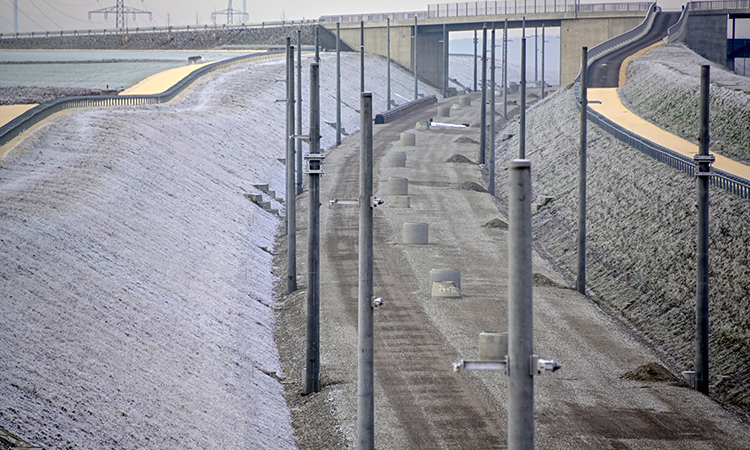

Spun concrete poles for RE330 for later overhead line installation. Credit: Arnim Kilgus
Each track is fitted with a return conductor at the poles (243-AL1) major section along the line refitted with a feeder wire (243-AL1).
Sectioning of the overhead contact line is realised by insulated overlaps in combination with pole mounted, remote controlled switches.
The installation of high-speed overhead contact lines has high requirements for the installation process. The first section was completed in October 2020, while the EBA certified engineers tested and verified the system in 2021. With the energisation of the system on 31 January 2022, the next project phase, including high-speed tests with up to 275km/h, will commence.


OUT NOW: The Definitive Guide to Rail’s Digital Future
The rail industry is undergoing a digital revolution, and you need to be ready. We have released our latest market report, “Track Insight: Digitalisation.”
This is not just another report; it’s your comprehensive guide to understanding and leveraging the profound technological shifts reshaping our industry. We move beyond the buzzwords to show you the tangible realities of AI, IoT, and advanced data analytics in rail.
Discover how to:
- Optimise operations and maintenance with real-time insights.
- Enhance passenger services through seamless, high-speed connectivity.
- Leverage technologies like LEO satellites to improve safety and efficiency.
Featuring expert analysis from leaders at Nomad Digital, Lucchini RS, Bentley Systems and more, this is a must-read for any rail professional.
Issue
Related topics
Electrification & Cabling, High-Speed Rail, Infrastructure Developments, Operational Performance, Sustainability/Decarbonisation, Track/Infrastructure Maintenance & Engineering
Related organisations
Deutsche Bahn AG (DB AG), German Federal Railway Authority (EBA)



